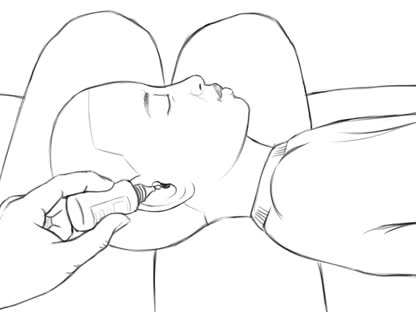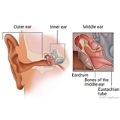Top of the pageCheck Your Symptoms
Earwax
Overview
Earwax is a natural substance that your body makes to protect the ear canal. It's a mixture of skin, sweat, hair, and debris (such as shampoo and dirt) held together with a fluid that comes from glands inside the ear canal (ceruminous glands). The ear canals are self-cleaning.
Earwax helps filter dust and keeps the ears clean. It also protects the ear canal from infection. Normally, earwax is a self-draining liquid that doesn't cause problems. As the skin of the ear canal sheds, the wax is carried to the outer part of the ear canal and drains from the ear by itself.
Earwax ranges in color from light to dark brown or orange. In children, earwax is usually softer and lighter than the earwax produced by adults. Children produce a lot of earwax. This tapers off as they grow older.
Earwax is normally produced only in the outer half of the ear canal. It won't cause a blockage unless it is pushed in. The ear canal may become blocked (impacted) when you try to clean the ear with cotton swabs, bobby pins, or your finger and push wax deeply into the ear canal. Impacted earwax may cause some hearing loss. It can also cause other problems, such as ringing in the ears (tinnitus), a full feeling in the ears, or vertigo. Poking at the wax with cotton swabs, your fingers, or other objects usually just further presses the wax against the eardrum.
Most earwax problems can be handled with home treatment. Professional help may be needed to remove tightly packed earwax.
Check Your Symptoms
The medical assessment of symptoms is based on the body parts you have.
- If you are transgender or nonbinary, choose the sex that matches the body parts (such as ovaries, testes, prostate, breasts, penis, or vagina) you now have in the area where you are having symptoms.
- If your symptoms aren’t related to those organs, you can choose the gender you identify with.
- If you have some organs of both sexes, you may need to go through this triage tool twice (once as "male" and once as "female"). This will make sure that the tool asks the right questions for you.
Many things can affect how your body responds to a symptom and what kind of care you may need. These include:
- Your age. Babies and older adults tend to get sicker quicker.
- Your overall health. If you have a condition such as diabetes, HIV, cancer, or heart disease, you may need to pay closer attention to certain symptoms and seek care sooner.
- Medicines you take. Certain medicines, such as blood thinners (anticoagulants), medicines that suppress the immune system like steroids or chemotherapy, herbal remedies, or supplements can cause symptoms or make them worse.
- Recent health events, such as surgery or injury. These kinds of events can cause symptoms afterwards or make them more serious.
- Your health habits and lifestyle, such as eating and exercise habits, smoking, alcohol or drug use, sexual history, and travel.
Try Home Treatment
You have answered all the questions. Based on your answers, you may be able to take care of this problem at home.
- Try home treatment to relieve the symptoms.
- Call your doctor if symptoms get worse or you have any concerns (for example, if symptoms are not getting better as you would expect). You may need care sooner.
Vertigo is the feeling that you or your surroundings are moving when there is no actual movement. It may feel like spinning, whirling, or tilting. Vertigo may make you sick to your stomach, and you may have trouble standing, walking, or keeping your balance.
Seek Care Today
Based on your answers, you may need care soon. The problem probably will not get better without medical care.
- Call your doctor or telehealth provider today to discuss the symptoms and arrange for care.
- If you cannot reach your doctor or telehealth provider or you don't have one, seek care today.
- If it is evening, watch the symptoms and seek care in the morning.
- If the symptoms get worse, seek care sooner.
What are your options for medical care?
Today your options for where to get your medical care are greater than ever before. You may not even have to leave your home to get the care you want and need. You can choose based on what your health problem is and what works best for you.
- Telehealth is a video call with a health care provider. It can be a convenient way to get medical advice or treatment. Some insurers provide access to telehealth that may be available 24 hours a day. Telehealth for less serious problems may cost less and be faster than in-person clinic visits.
- Urgent care and retail clinics are options if you don't have a doctor, you can't or don't want to wait to see your own doctor, or a telehealth visit can’t treat the problem.
- Virtual care from your primary provider or a telehealth service can be delivered through your smartphone, computer, or tablet.
Make an Appointment
Based on your answers, the problem may not improve without medical care.
- Make an appointment to see your doctor in the next 1 to 2 weeks, or contact your telehealth provider.
- If appropriate, try home treatment while you are waiting for the appointment.
- If symptoms get worse or you have any concerns, call your doctor or telehealth provider. You may need care sooner.
What are your options for medical care?
Today your options for where to get your medical care are greater than ever before. You may not even have to leave your home to get the care you want and need. You can choose based on what your health problem is and what works best for you.
- Telehealth is a video call with a health care provider. It can be a convenient way to get medical advice or treatment. Some insurers provide access to telehealth that may be available 24 hours a day. Telehealth for less serious problems may cost less and be faster than in-person clinic visits.
- Urgent care and retail clinics are options if you don't have a doctor, you can't or don't want to wait to see your own doctor, or a telehealth visit can’t treat the problem.
- Virtual care from your primary provider or a telehealth service can be delivered through your smartphone, computer, or tablet.
Self-Care
Don't try to remove earwax if you have ear pain or a discharge that looks different than earwax, if you think you have a ruptured eardrum, if you have had ear surgery, or if you have tubes in your ears.
You may be able to remove earwax yourself. Here's how.
- Soften and loosen the earwax.
Use warm mineral oil or a mixture of hydrogen peroxide mixed with an equal amount of room-temperature water.
- Place 2 drops of the fluid, warmed to body temperature, in the ear twice a day for up to 5 days.
Be sure to warm the fluid. Cold fluid can cause pain and dizziness.
- Place 2 drops of the fluid, warmed to body temperature, in the ear twice a day for up to 5 days.
- Remove the wax.
When the wax is loose and soft, all that's usually needed to remove it from the ear canal is a gentle, warm shower.
- In the shower, let water flow into the ear.
- Then tip your head to let the earwax drain out.
- Dry your ear.
- Use a towel to gently dry your ear.
- Use wax softener for stubborn earwax.
- Use a nonprescription wax softener if the warm mineral oil and shower don't work.
- Then flush gently with an ear syringe each night for a week or two.
Make sure the flushing solution is body temperature. Cool or hot fluids in the ear can make you dizzy.
Protect your ears.
- Don't use cotton swabs, bobby pins, or other objects to clean the ear.
- Do not use a dental irrigation device, such as a Water Pik, to remove earwax. The force of the water injures the ear canal and ruptures the eardrum.
- Do not use ear candles. They have no proven benefit in the removal of earwax. They can cause serious injury.
When to call for help during self-care
Call a doctor if any of the following occur during self-care at home:
- New or worse bleeding or drainage.
- New symptoms, such as hearing loss or dizziness.
- The ear canal or skin around the ear becomes red, swollen, itchy or painful.
- Symptoms occur more often or are more severe.
Learn more
Watch
Preparing For Your Appointment
You can help your doctor diagnose and treat your condition by being prepared for your appointment.
Credits
Current as of: October 27, 2024
Author: Ignite Healthwise, LLC Staff
Clinical Review Board
All Ignite Healthwise, LLC education is reviewed by a team that includes physicians, nurses, advanced practitioners, registered dieticians, and other healthcare professionals.
Current as of: October 27, 2024
Author: Ignite Healthwise, LLC Staff
Clinical Review Board
All Ignite Healthwise, LLC education is reviewed by a team that includes physicians, nurses, advanced practitioners, registered dieticians, and other healthcare professionals.

